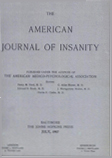NON-SPECIFIC PROTEIN THERAPY IN NEUROSYPHILIS
Abstract
First. In non-specific protein therapy (combined typhoid and paratyphoid vaccine) of cerebral syphilis and paresis, we have an excellent substitute for malarial inoculation.
Second. In a series of fifty-five unselected cases treated by this means, results obtained compare quite favorably with malarial therapy, and appear superior to the other methods of treatment thus far advocated.
Third. It is better tolerated more benign in action, can be given in advanced cases of syphilitic brain disease, also where malaria is not readily obtainable or is otherwise contra-indicated.
Fourth. The average height of temperature in these cases was 103 degrees; the highest temperature registered being 108 degrees on two successive occasions in a recently treated patient on injections of only two hundred million dead bacilli at each injection.
Fifth. The tolerance and reactions of the patient to this therapy are generally very good even with injections increased to three billion five hundred million dead bacilli per dose.
Sixth. The secondary anemia and loss in weight is appreciably less marked than that encountered with the malaria inoculations and the patient's recovery from the effects of the treatment is often very rapid.
Seventh. Serologically, the most striking reduction occurs in the colloidal mastic or gold curve test. In more than eighty per cent of the cases treated, modification occurred from a high paretic curve to a negative one. The average reduction however being to a luetic zone curve, varying degrees of modification may also occur in the Wassermann reactions of the blood and spinal fluids.
Eighth. This treatment may be repeated a second or third time at intervals of two or more months with very little or no hazard to the patient.
Ninth. Tables 1, 2 and 3 serve to show the various degrees of modification obtained in the serological findings, before and after treatment as compared with the clinical improvement manifested.
Access content
To read the fulltext, please use one of the options below to sign in or purchase access.- Personal login
- Institutional Login
- Sign in via OpenAthens
- Register for access
-
Please login/register if you wish to pair your device and check access availability.
Not a subscriber?
PsychiatryOnline subscription options offer access to the DSM-5 library, books, journals, CME, and patient resources. This all-in-one virtual library provides psychiatrists and mental health professionals with key resources for diagnosis, treatment, research, and professional development.
Need more help? PsychiatryOnline Customer Service may be reached by emailing [email protected] or by calling 800-368-5777 (in the U.S.) or 703-907-7322 (outside the U.S.).



